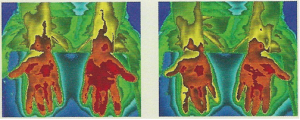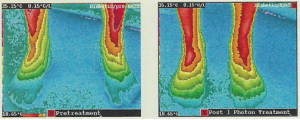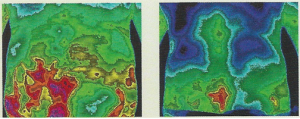
An Innovative Approach to Pain Management and Dysfunction
How does Photon Therapy Work?
Photon therapy uses a medical device called the BioPhoton which emits non-laser, near infrared light in packets called Photons. Photons break the painful inflammatory cycle by dilating small blood and lymphatic vessels. This increase in circulation removes the irritating inflammatory products and results in accelerated healing and pain relief. The immune system and nervous system are also stimulated by photons, which increases activity and leads to faster repair of damaged tissues. Numerous tests show that the increase in circulation and reduction in pain associated with the use of photons is the result of an increase in the release of nitric oxide directly under the neuro-transmitter.
Are the treatments painful?
Unlike other modalities, no sticky pads or cold gels are required. Most patients feel no particular sensation other than a slight warmth caused from increased blood circulation to the treatment area.
Is there any radiation danger or potential to be burned or shocked?
BioPhoton Therapy does not emit any x-ray or other ionizing radiation. It only emits diffused light. Unlike a laser’s focused light, light emitted by this therapy reduces the risk of burn.
Are there any contraindications?
As with any therapy, it is not applied over cancer, infection, a pregnant uterus, or at any time to the eyes. Patients with these conditions may be treated with photon therapy at other locations in their body. Both patient and practitioner must wear safety glasses during treatment to protect the eyes.
What are the advantages compared to other therapies?
- Faster Healing
- Anti-Inflammatory Action
- Increased Vascular Activity
- Stimulates Nerve Function
- Fast
- Non-Pharmalogical
- Safe
- Non-Invasive
- Economical

Can Photon Therapy be combined with other therapies?
Yes. BioPhoton Therapy works well alone or with other therapies such as acupuncture, chiropractic, and physical therapy.
How many treatments do I need?
The varies based on many factors, including chronicity of disease, strength of immune system, frequency of treatments, and much more. A series of 4 treatments is usually administered to evaluate effectiveness and determine the appropriate number additional sessions.
Is Photon Therapy safe for Seniors and Children?
Yes. Because the treatment is so comfortable, children and seniors usually welcome it’s beneficial effects. It is also safe to apply photon therapy over many types of planted medical devices. Both patient and doctor must wear safety glasses during treatment to protect the eyes.
BioPhoton Therapy uses a focused, powerful wave of light to penetrate the skin, tissue, and surrounding nerves. Changes in blood circulation can be seen utilizing a special camera that takes infrared (heat) images of the body. Over a series of treatments, blood circulation is restored allowing the body to heal itself.

Infrared image of carpal tunnel syndrome before and after BioPhoton Therapy. Smaller hot areas show decreased inflammation.

Diabetic neuropathy before and after BioPhoton Therapy treatment. Warmer colors indicate increased circulation.

Failed back syndrome before and after a series of BIoPhoton Therapy treatment. Reduced number of hot spots show decreased inflammation.
Conditions Treated by BioPhoton Therapy
The following are examples of conditions successfully managed with photon therapy:
Auto, work and sports injuries
Back pain (herniated disc, radiculopathy, etc.)
Knee pain
Headache
Neuropathies (diabetic, painful, chemotherapy-induced)
Wound healing (burns, cuts, and contusions)
Postoperative Pain
Chronic Regional Pain Syndrome (Type I & II)
Myofascial (muscle) Pain
Repetitive Stress Injuries
Plantar Fasciitis
Bell’s Palsy
Carpal Tunnel Syndrome
Failed Back Syndrome
Thoracic Outlet Syndrome
Osteoarthritis
Whiplash


